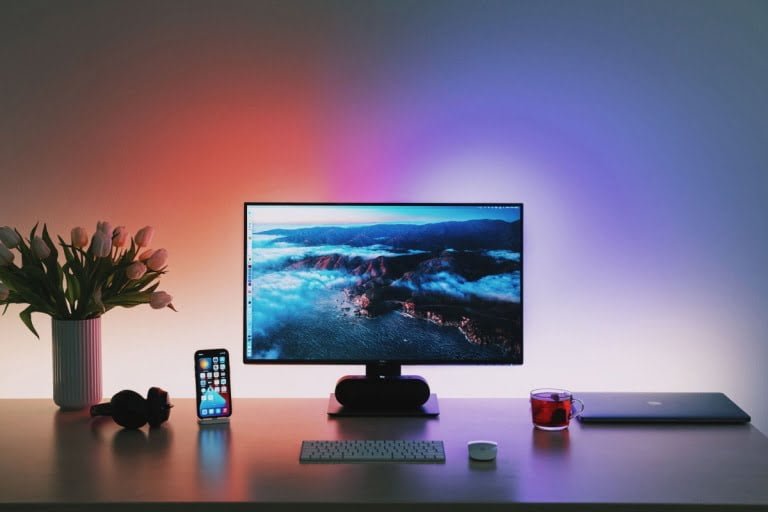Nowadays, all computers support 1080-pixel resolution, but the 1440p is slowly becoming the new standard in the gaming monitors. So, if you are looking for an upgrade, and you cannot afford a 4K monitor, the best thing you can do is to turn to its budget-friendly alternative, namely the 1440p monitors.
Below, you will find a detailed guide on 1440p monitors that will help you decide for yourself if they a worthy addition to your dream setup.
- Samsung LC32G75T – The Best Curved Gaming Monitor Out There
- MSI Optix MAG274QRF-QD – Best Co-Op 1440p Gaming Monitor
- AOC Q27V4EA – Best 1440p Monitor on a Budget
- Acer Predator X35 – Best Ultrawide HDR Gaming Monitor
- ASUS TUF Gaming VG27AQ – Best Monitor for Casual Gaming
- LG 32GN650 – Monitor with the Best Design
- For NVIDIA GPU Owners: Best G-Sync monitor
- For AMD GPU Owners: Best FreeSync monitor
- How to Choose a 1440p Monitor?
Samsung LC32G75T – The Best Curved Gaming Monitor Out There

The Samsung LC32G75TQSNXZA is the best gaming monitor according to our research. It comes in two different sizes to match every gamers’ needs. Not only that but it also rocks a ridiculously high refresh rate of 240Hz which is enough to see everything as smooth as real life.
It’s not your typical ultrawide gaming monitor but is by far the top choice when it comes to a curved gaming monitor. If what we already mentioned is not enough, it supports FreeSync variable refresh rate (VRR) technology natively. Additionally it’s NVIDIA certified to work with the G-Sync compatible mode, making it very versatile.
The Samsung LC32G75T (also known as the Odyssey G7), is perfect fro gaming among other things mainly due to its very high refresh rate of 240 hz. Moreover, it has beautiful colors and probably the best blacks on the market, thanks to its VA panel, which is perfect for gaming in the dark.
Another great advantage the Odyssey G7 has over other gaming monitors is the great contrast ration even with the brightness cranked all the way up. This way you will be sure all the information on your screen is visible and you will take full advantage of the entire display.
The Samsung Odyssey G7 is also perfect for media creation. The fantastic coverage of the Adobe RGB color space will help all the photographers, video makers and graphic designers create the best content they can. Something the pixel peeper in you would love, is the exceptional handling of gradients.
Even though the LC32G75T supports HDR with yet again, a fantastic contrast ratio, it has some disadvantages. This is, among others, the limited brightness that might be annoying in bright conditions. Additionally, the monitor has a rather sub-par local dimming feature which you might find annoying.
Depending on the type of performance you’ll need, you might be able to get over the low brightness thanks to the exception handling of gradients and the wide color gamut. Moreover, you probably won’t need higher brightness that much, because the display barely reflects external light.
When it comes to additional features, the Odyssey G7 also has the edge over the competitors. It rocks two USB 3.0 ports and a Picture-in-Picture mode that lets you display signals from two input sources at once. While this might not be that useful for some of you, it’s great for streaming on any gaming platform.
The only downsides that we could find, are the rather narrow viewing angles and the lack of compatible height-adjustable stand. The narrow viewing angles are due to the VA panel, which is what makes it the best 1440p gaming monitor so it shouldn’t be a bother.
- WQHD RESOLUTION: Make your gaming world, more lifelike than ever before.
- NVIDIA G-SYNC & FREESYNC.
- RAPID 240hz REFRESH RATE: Topping leaderboards never looked or felt so smooth. With Odyssey’s rapid 240hz refresh rate, you have up to four times as many frames displayed on screen every second compared to a traditional screen.
- LIGHTNING FAST 1ms RESPONSE TIMES: A fraction of a second can be the difference between your destruction, or your enemy’s.
MSI Optix MAG274QRF-QD – Best Co-Op 1440p Gaming Monitor
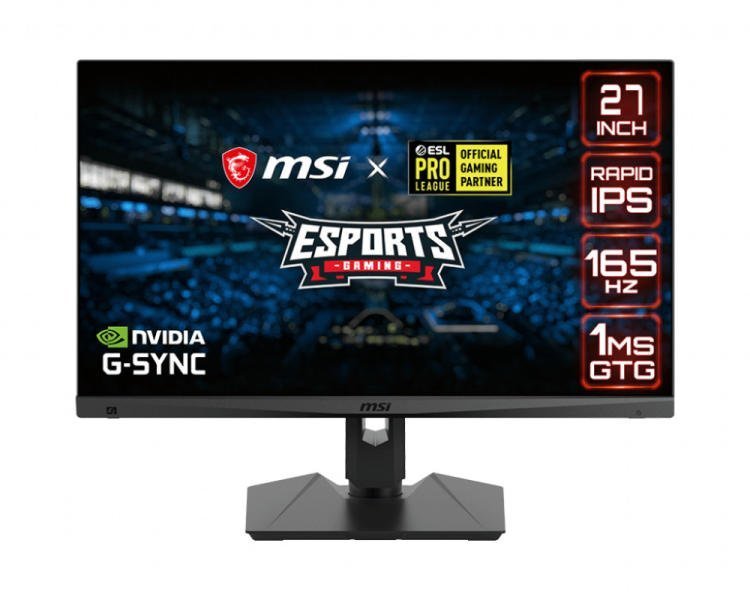
The MSI Optix MAG274QRF-QD came pretty close to getting the first place in our list. It came second only because it lags behind when it comes to refresh rate and contrast. Nevertheless, the differences are only minor and it’s still one of the best monitors for gaming out there.
This MSI monitor still has a high refresh rate at 165hz which will give you an incredibly clear image with no distracting ghosting and virtually no blurry fast-moving objects. It also has great ergonomics, letting you view the entire display from anywhere you’re sitting, letting you give your best performance no matter what you’re playing.
Additionally, the screen has wide viewing angles, which would make it a great option for when you have people around you. Moreover, it comes certified to work with AMD’s FreeSync and NVIDIA’s G-SYNC modes, giving you a great gaming experience with any console or PC that supports VRR. MSI has also given you a great selection of inputs, letting you connect multiple sources. Unfortunately it lacks support for HDMI 2.1, stopping it from giving you the best performance on PS5 and Xbox Series X.
The MAG274QRF-QD comes with decent HDR but no local dimming. While the color gamut for HDR content is great, thanks to the quantum dot technology, the blacks aren’t very convincing. If you’re looking at the display from a poor viewing angle they might even seem gray.
Another disadvantage that this screen has is the rather poor contrast ratio and brightness. This means that bright highlights may not stand out very well. A partial compensation for that is the lack of reflections, which makes the display easier to see.
Another weak point for the screen is that the color reproduction is a bit odd. For photographers, designers and video makers they might seem a bit too saturated. This can be easily fixed with some calibration.
AOC Q27V4EA – Best 1440p Monitor on a Budget
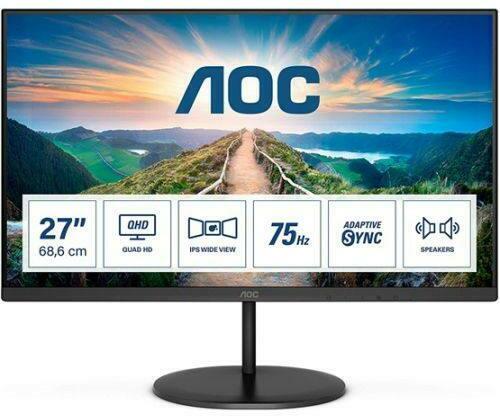
This AOC screen is the best 1440p monitor if you’re shopping on a budget. It has the best design among all the others with a very minimalist stand that offers some tilt and tiny bezels on the sides. The Q27V4EA is an IPS display with a 2560×1440 resolution and a decent response time of just 4ms.
It has pretty great contrast for such a cheap monitor, which is actually a bit better than the MSI Optix when consuming HDR content. Unfortunately the brightness isn’t the greatest but it should do for indoor use.
Additionally, the color reproduction is significantly more accurate than we expected, especially when comparing to the rest of the monitors in the same price range. It delivers around 89% coverage of the sRGB gamut which means that you’ll be consuming most of the content, just as the creator intended it.
At 70 hz refresh rate, this AOC display is not going to be the best for gaming, but with such great colors, it should still be fine. Unfortunately this monitor comes with just handful of ports, which might get in your way, if you’re planning to use something more than HDMI.
Additionally, the menu is a bit complicated to navigate, and the controls are simply a bunch of buttons in the bottom right corner. This can make it difficult to navigate and you might have to spend more time setting it up.
- AOC 32" (31.5" viewable) widescreen monitor with 2K QHD 2560 x 1440 resolution
- VA panel delivers superior consistency in color temperature, wide viewing angles, and crisp contrast
- Wide color gamut with 103% sRGB area coverage for truer colors, ideal for graphics intensive work and viewing sessions
- LowBlue mode that reduces the amount of harmful blue spectrum of light to help prevent eye stress
Acer Predator X35 – Best Ultrawide HDR Gaming Monitor
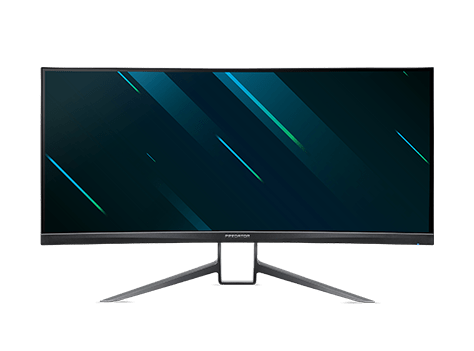
The Acer Predator X35 was one of the most eagerly anticipated monitors when it was first presented. It promised a 512-zone full-array local dimming that would give you fantastic HDR capabilities and a refresh rate of up to 200hz for a buttery-smooth performance.
The Acer X35 is a 35″ (as the name gives away) monitor with a 3440×1440 resolution and 10-bit color depth support. It is made with a quantum-dot enhanced film (QDEF) layer, allowing it to have life-like color reproduction. Additionally, the peak brightness is 600 nits and up to 1000 nits for HDR content making it a great option even for bright environments.
The advantages of this beast of a display don’t end there. Its contrast ratio is 2500:1, which provides beautiful blacks and bright whites. It’s around 2.5 times the contrast ratio IPS monitors offer.
If that’s not enough, the 512-zone full-array local dimming pushes the contrast even higher to around 7500:1. If you’re watching HDR content that can go even higher to over 100 000:1. As a result you get details in the highlights and shadows, unmatched by other monitors.
A disadvantage the Acer Predator X35 has are the lack of G-SYNC support for AMD GPU’s which might leave your picture with some ghosting at high framerates. Furthermore, when you have 10-bit color enabled and full 4:4:4 color range, the display refresh rate is limited to 144hz. If you want to go to its maximum capacity of 200hz, you’ll need to switch to 8-bit color. That shouldn’t be a problem if you’re planning to use it for gaming, as most games only support 8-bit color.
The monitor has premium build quality with a metal stand and a wide range of ergonomics, among which a 130mm height adjustment and a 30 degree swivel and tilt.
You also have a bunch of connectivity options including DisplayPort 1.4, HDMI 2.0, four USB 3.0 ports and audio port and two 4W speakers.
Adding to the previously mentioned great brightness, the screen has fantastic anti-glare coating, which eliminates reflections almost completely. This gives you a more immersive experience when gaming.
- 35" UltraWide QHD (3440 x 1440) Widescreen VA zero frame display with NVIDIA G-SYNC ultimate for ultimate tear free gaming
- 1800R Curved Display with 21: 9 Aspect Ratio | High brightness and contrast with VESA certified display HDR 1000.
- DCI-P3 90% wide color gamut | 10bit color with Quantum dot technology.
- Light your display with Acer RGB light sense & 512 full array local dimming zones.
ASUS TUF Gaming VG27AQ – Best Monitor for Casual Gaming
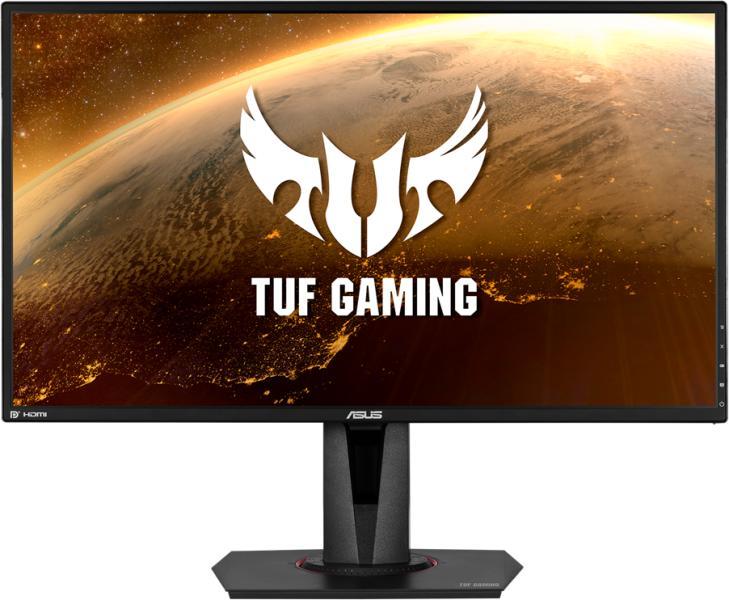
The ASUS TUF VG27AQ is arguably the best versatile monitor on the market, that’s also great for casual gaming. It comes equipped with an IPS panel with fantastic color reproduction, wide viewing angle and pretty decent response time. All of that is mounted on a very ergonomic stand that lets you position it just the way you want it.
The TUF VG27AQ is additionally a fantastic monitor for gaming thanks to its 165hz refresh rate and surprisingly good response time. With the wide viewing angle that the screen has, you can be sure that it will be fantastic for co-op gaming sessions with your buddies.
This ASUS display is just as good for office use, as it is for gaming. With the fantastic screen size of 27″ you will have plenty of real estate for all work tasks to fit on the screen. Here, the ergonomic stand comes in handy, as you will probably be spending a lot of time in front of it in the office. Additionally even if you leave the blinds up, the screen gets very bright so you’ll be able to see everything fairly clearly.
The TUF VG27AQ is surprisingly good for creating and consuming content. That’s because of its wide viewing angle and low reflections. This will let you enjoy a movie with a friend and help you see colors accurately when editing photos or designing.
The biggest weak spot the screen has is HDR. Even though it’s supported the color gamut is not as wide as we would’ve liked it to be. Additionally blacks have more of a grayish tone to them, which can be annoying. Moreover, the display barely gets bright enough to bring out any highlights.
- 27 inch WQHD (2560x1440) IPS gaming monitor with 1ms (MPRT) response time 165Hz refresh rate (supports 144Hz) and G-SYNC compatibility for a tear-free experience
- ASUS Extreme Low Motion Blur Sync (ELMB Sync) Technology enables a 1ms response time
- Marathon ready with ASUS Eye Care technology to minimize eye fatigue
- Compatible with industry-standard HDR10 High Dynamic Range for amazing color and brightness levels.
LG 32GN650 – Monitor with the Best Design
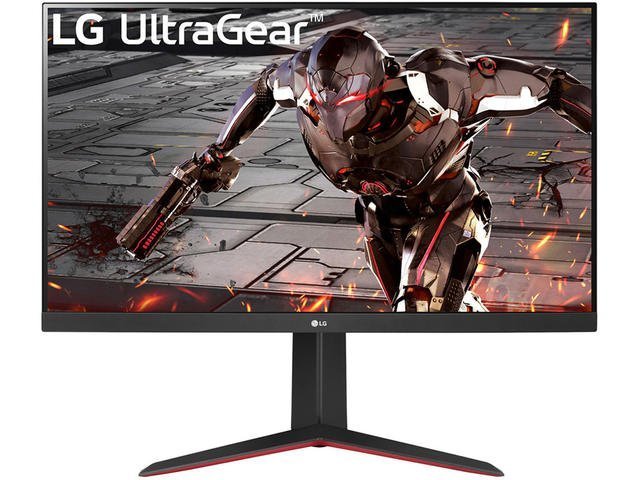
This LG monitor does not only come with great looks but also has some power under the hood thanks to the VA panel by AU Optronics. Compared to your regular IPS monitor, the 32GN650 has a higher static contrast ratio of 3000:1, letting it achieve deep blacks and great details in the shadows. Unfortunately that comes at a price, as the viewing angles are somewhat worse than those of an IPS panel. While you’re sitting in front of the monitor you should be fine, though.
The monitor has a somewhat unconvincing peak brightness of 350 nits which should be enough for use in normal conditions. Don’t expect it to look great with bright sunlight, though.
The display has among the best color reproductions on the market today without the need for calibration. It covers around 95% of the sRGB color space giving accurate colors which makes it perfect for content creation and editing of visual content. If you are only planning to use the monitor only for gaming you might not like that as it doesn’t have the extra saturation some other displays have.
Nevertheless, the QHD resolution offers a pixel density of 93 PPI (pixels per inch). That is going to make everything you see crispy clear.
The 165hz refresh rate will give you supreme performance at a high framerate making every movement seem smooth. Combined with the beautiful blacks, this will be great for gaming at night. Furthermore the LG 32GN650 supports AMD FreeSync with a 48-165 hz variable refresh rate (VRR) for tear-free gameplay up to 165 fps.
Unfortunately NVIDIA G-SYNC is not fully supported on this monitor. You can still use VRR with GeForce GTX 10-series and newer GPUs. To do that you will have to connect it to the monitor over DisplayPort which might make the performance a bit choppy.
The 32GN650 does not only look good but is very easily adjustable. It can be tilted -5°/15° and the height can be adjusted up to 110mm. In addition, it offers a 90 degree pivot and 100x100mm VESA mount compatibility.
For NVIDIA GPU Owners: Best G-Sync monitor
If you own a recently launched NVIDIA video card model, you’d better browse through the G-Sync capable monitors
For AMD GPU Owners: Best FreeSync monitor
If you a proud owner of one of the latest AMD video cards, then you should pair it with a FreeSync-enabled monitor.
How to Choose a 1440p Monitor?
If you are wondering whether a 1440p monitor is the best option for you, here are the main guidelines you should follow.
Does your gaming rig support 1440p?
If you play The Witcher, the Elder Scrolls, Destiny, Monster Hunter: World, and you want to enjoy the fascinating graphics on a 1440p monitor, you’d better make sure your rig can support it, otherwise you risk being disappointed by the image quality.
Are you a multitasker?
If you are looking for a versatile monitor for gaming, web surfing, watching movies, a 1440p monitor is a nice upgrade and all these activities will be more enjoyable.
You are a PC gamer
It is a well-known fact that console players often hook their PS and Xbox consoles to a monitor and they have a good reason to do that. As pointed in our buyer’s guide, there is a great difference between running games on a gaming monitor and using a TV, be it the most sophisticated one. However, the latest consoles play games at 1080p meaning a console gamer would not make a good use of a 1440p monitor even if they have a decent graphics card.
What is 1440p?
The 1440p monitors have been gaining more and more popularity among gamers and there must be a good reason why they speak well of their capabilities. In brief, the term 1440p monitor stands for a monitor that has a max resolution of 2,560 x 1,440 and 16:9 aspect ratio. What makes them superior to their 1080p HD siblings is the enhanced visuals. The 1440p monitors are also called QHD, Quad HD or WQHD. The 1440p monitors considerably improve the image clarity, especially at the close range. Keeping in mind that gamers do not stay more than 30 inches away from the monitor, they can enjoy crisp visuals and stunning effects. But why should you get a 1440p monitor instead of 4K? Well, 4K monitors are not everyone’s cup of tea not only because of the ludicrous price, but also because of the powerful GPU they require. If you need some solid arguments for and against 1440p monitors, keep reading and make an informed decision.
4K vs. 1440p
The 4K monitors are the jewel in the crown of the gaming monitors right now, but buying a 4K monitor requires a serious upgrade of the internal hardware as the higher resolution requires a more powerful graphics card. A 1440p monitor is more likely to be compatible with your current hardware, not to mention that purchasing a 4K monitor without upgrading the internal hardware will lead to refresh rate issues. In addition, the 4K is a relatively new technology and not all games support it. What’s more, most developers still struggle with making their games truly compatible with 4K, but 99% of the existing games will run beautifully on a 1440p monitor.
If you want a high-quality upgrade and you don’t want to break the bank, but at the same time you do not want to go with a randomly picked cheapo, a 1440p monitor is the perfect fit.
Equipment required for gaming on 1440p resolution
The first thing you have to take into account is whether your hardware is capable of running games on 1440p resolution, otherwise you will have to reduce the resolution to an acceptable range or disable some of the effects. To be able to play at 2560 x 1440, you have to make sure your graphics card is at least GTX 750 or R7 370. To enjoy a smooth gameplay at 60Hz, you ideally need a R9 390X or GTX 980.
If you want to get a 1440p monitor and play at 144Hz, you need GTX 1080 graphics card or at least GTX 1070Ti. If you choose a monitor with an adaptive sync technology, you will get a more stable FPS. The input lag as well as the screen tearing will be dramatically reduced.
FreeSync vs. G-Sync
Your choice of a 1440p monitor should be determined by the graphics card you use, or you are planning to buy – AMD or Nvidia. You will still be able to use a FreeSync monitor with a Nvidia graphics card and vise versa, but you will not be able to benefit from the dynamic sync feature.
The G-Sync offers a wider dynamic range, and it is also said to be better at reducing the input lag, although the gaming community is divided over the advantages and disadvantages of these two technologies.
To sum up, both technologies will give you an edge over the competition, so whichever you settle for, you may rest assured that would be one of the best investments you will make to your gaming rig.
What about the Refresh Rates? 60Hz, 144Hz, or 165Hz?
Before you consider the purchase of a 1440p monitor, you have to take into account the refresh rate, too. If you are mainly into first person shooters, the refresh rate is of critical importance. If you play Call of Duty, Overwatch or any other trending shooter at 60Hz monitor, chances are that you will be shooting at targets that are not exactly where they appear to be. In other words, for competitive FPS, the best thing you can do is to get a 1440p 144Hz rate monitor, or even a 240Hz monitor. This takes us to the next important question: should you get a 144Hz monitor or opt for a model that allows overclocking to 165Hz?
The difference between 144Hz and 165Hz might be negligible to some and critically important to others. In casual gaming, having a 165Hz gaming monitor and middle of the road graphics card will not make a big difference. For professional gamers, every millisecond can be a reason for a humiliating loss. For gamers who have no intentions to conquer the professional gaming scene, a 144Hz monitor will suffice.

